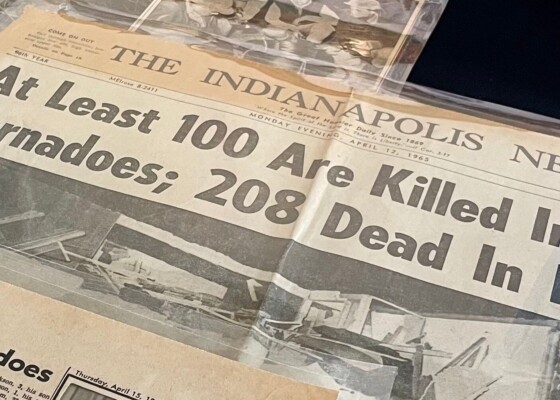Oliver’s Woods: A Recap
May 24, 2016There aren’t a lot of nature preserves that have Bed, Bath, & Beyond and Old Navy stores as neighbors, but Oliver’s Woods does. Oliver’s Woods is a 53-acre plot of…
There aren’t a lot of nature preserves that have Bed, Bath, & Beyond and Old Navy stores as neighbors, but Oliver’s Woods does.
Oliver’s Woods is a 53-acre plot of land nestled between the White River and a stretch of I-465 in north Indianapolis. If you live in Indy, you probably drive by it dozens of times a year without knowing it. It was donated to the Central Indiana Land Trust by the Daugherty family a few years ago and has yet to be opened to the public.
But on a recent Wednesday night, I got a chance to check it out with about 30 other Hoosiers on the inaugural outing of the Next Indiana Campfires program.
We gathered around the campfire about an hour before dusk and read Mary Oliver’s “The Summer Day,” a short poem that urged us all to pay attention to the world around us, no matter how small, and to take time to “be idle and be blessed” while we “strolled the fields.” Bearing that thought in mind , we grabbed our water bottles (or in some cases, our cans of Upland Brewing Co. beer) and hit the trail.
Cliff Chapman, our resident naturalist, walked us along the river bank, through the woods, and along a path surrounded on both sides by hyacinths. We stopped along the way to read a selection from Michael Martone, a Fort Wayne native who inspired us to find beauty in the flatness of the Midwest. Martone observes that the “slight elevations” of the Midwestern landscape can be easily missed, but if you live here for a while, your “meter calibrates to it” and you “learn to read the flatness and to feel the slight disturbances in the field.”
When we returned to the campfire about an hour later, we roasted hot dogs, s’mores, and helped ourselves to another beer before reading Wallace Stegner’s “Wilderness Letter” from 1960. Stegner, a Pulitzer winner known for his efforts at conversation, prodded us to contemplate the “idea of the wilderness” apart from any of its utilitarian values. “We need wilderness preserved – as much of it as is still left, and as many kinds – because it was the challenge against which our character as a people was formed,” he wrote. “The reminder and the reassurance that it is still there is good for our spiritual health even if we never once in ten years set foot in it.”
So there we were, enjoying the green of spring and the fire and some inspired conversation, when a severe thunderstorm popped up and sent us running to our cars! But everything was fine, and as I drove home I pondered some of the things I had heard along the trail:
- “Dead things are more important than living things from an ecological point-of-view.” From our 21st-century American perspective, that’s a counterintuitive notion. We tend to think that the dead things (fallen leaves, rotting trees, etc.) should be swept out of the way to make way for the living things, but in fact the living things need the dead things. When we clear away the dead, we undermine the living.
- “Finding beauty in Indiana develops your eye for beauty.” About a third of our group were non-native Hoosiers—people like myself who came here from the beaches or the mountains. Those places have a beauty that is easy and obvious—but also, perhaps, a bit cliché at this point. It is harder to find beauty in a wetland or a prairie, but it’s there, and when you find it, it’s fresh. Even when it’s next to Keystone Crossing.
- “Sometimes the camera helps me pay more attention.” We tend to think that to experience the beauty of nature, we need to unplug from our devices. But one hiker said that becoming a photographer actually forced her to look more and focus better than she had ever done before.
- “I love Indiana. I love this place.” When Cliff said this, we all nodded our heads and said an “amen.” It struck me as so spontaneous and un-ironic. A week prior to our hike, our state was overrun with the hype of presidential candidates and local politics with all of its attendant cynicism, and its echoes hung in the air like the grind and whoosh of traffic on nearby I-465. How refreshing to hear a simple, honest declaration of love for this place, this land.
- “We have to feed people and build an economy, but we have to take care of the earth. How do we strike that balance?” This was one of the last questions we heard before the storm scattered us, and it’s the one that I carried away. It’s a hard question. I thought of a few lines by Wendell Berry, who said “To make a living isn’t to make a killing. To make a living is to make enough.” We will need voices like his to help us understand and remember that.
For those who want to connect with those voices that come from the Hoosier state, Susan Neville’s “On Common Ground: Indiana Literature and the Land” provides a brief, historical overview. You can find it in “Sailing the Inland Sea.”
Interested in attending on of our Next Indiana Campfire events? Register for one (or many!) here.
—————————————————-
Next Indiana Campfires is a unique way to connect nature, literature and Indiana’s Bicentennial. The program is supported by the Efroymson Family Fund, the Nina Mason Pulliam Charitable Trust and Pulitzer Prizes Centennial Campfires. Indiana Humanities is supported in part by Lilly Endowment Inc. and the National Endowment of the Humanities.
This post, written by Del Doughty, Associate Dean for Academic Affairs and Professor of English at Huntington University, is part of the weekly blog series devoted to the initiative. Check back every Tuesday to learn more about Indiana’s great environmental literature, find out interesting facts about Hoosier stewardship, get all the latest program details and more.


